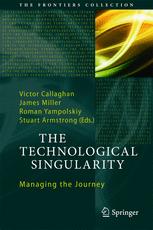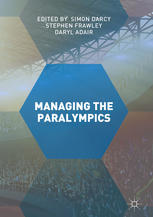The Technological Singularity Managing the Journey 1st Edition by Victor Callaghan ISBN 3662540339 9783662540336
$50.00 Original price was: $50.00.$25.00Current price is: $25.00.
The Technological Singularity Managing the Journey 1st Edition by Victor Callaghan – Ebook PDF Instant Download/Delivery: 3662540339, 978-3662540336
Full download The Technological Singularity Managing the Journey 1st Edition after payment

Product details:
ISBN 10: 3662540339
ISBN 13: 978-3662540336
Author: Victor Callaghan
The Technological Singularity Managing the Journey 1st Table of contents:
1. Introduction to the Technological Singularity
1.1 Why the “Singularity” Is Important
1.2 Superintelligence, Superpowers
1.3 Danger, Danger!
1.4 Uncertainties and Safety
References
2. Risks of the Journey to the Singularity
2.1 Introduction
2.2 Catastrophic AGI Risk
2.2.1 Most Tasks Will Be Automated
2.2.2 AGIs Might Harm Humans
2.2.3 AGIs May Become Powerful Quickly
2.2.3.1 Hardware Overhang
2.2.3.2 Speed Explosion
2.2.3.3 Intelligence Explosion
References
3. Responses to the Journey to the Singularity
3.1 Introduction
3.2 Post-Superintelligence Responses
3.3 Societal Proposals
3.3.1 Do Nothing
3.3.1.1 AI Is Too Distant to Be Worth Our Attention
3.3.1.2 Little Risk, no Action Needed
3.3.1.3 Let Them Kill Us
3.3.1.4 “Do Nothing” Proposals—Our View
3.3.2 Integrate with Society
3.3.2.1 Legal and Economic Controls
3.3.2.2 Foster Positive Values
3.3.2.3 “Integrate with Society” Proposals—Our View
3.3.3 Regulate Research
3.3.3.1 Review Boards
3.3.3.2 Encourage Research into Safe AGI
3.3.3.3 Differential Technological Progress
3.3.3.4 International Mass Surveillance
3.3.3.5 “Regulate Research” Proposals—Our View
3.3.4 Enhance Human Capabilities
3.3.4.1 Would We Remain Human?
3.3.4.2 Would Evolutionary Pressures Change Us?
3.3.4.3 Would Uploading Help?
3.3.4.4 “Enhance Human Capabilities” Proposals—Our View
3.3.5 Relinquish Technology
3.3.5.1 Outlaw AGI
3.3.5.2 Restrict Hardware
3.3.5.3 “Relinquish Technology” Proposals—Our View
3.4 External AGI Constraints
3.4.1 AGI Confinement
3.4.1.1 Safe Questions
3.4.1.2 Virtual Worlds
3.4.1.3 Resetting the AGI
3.4.1.4 Checks and Balances
3.4.1.5 “AI Confinement” Proposals—Our View
3.4.2 AGI Enforcement
3.4.2.1 “AGI Enforcement” Proposals—Our View
3.5 Internal Constraints
3.5.1 Oracle AI
3.5.1.1 Oracles Are Likely to Be Released
3.5.1.2 Oracles Will Become Authorities
3.5.1.3 “Oracle AI” Proposals—Our View
3.5.2 Top-Down Safe AGI
3.5.2.1 Three Laws
3.5.2.2 Categorical Imperative
3.5.2.3 Principle of Voluntary Joyous Growth
3.5.2.4 Utilitarianism
3.5.2.5 Value Learning
3.5.2.6 Approval-Directed Agents
3.5.2.7 “Top-Down Safe AGI” Proposals—Our View
3.5.3 Bottom-up and Hybrid Safe AGI
3.5.3.1 Evolutionary Invariants
3.5.3.2 Evolved Morality
3.5.3.3 Reinforcement Learning
3.5.3.4 Human-like AGI
3.5.3.5 “Bottom-up and Hybrid Safe AGI” Proposals—Our View
3.5.4 AGI Nanny
3.5.4.1 “AGI Nanny” Proposals—Our View
3.5.5 Motivational Scaffolding
3.5.6 Formal Verification
3.5.6.1 “Formal Verification” Proposals—Our View
3.5.7 Motivational Weaknesses
3.5.7.1 High Discount Rates
3.5.7.2 Easily Satiable Goals
3.5.7.3 Calculated Indifference
3.5.7.4 Programmed Restrictions
3.5.7.5 Legal Machine Language
3.5.7.6 “Motivational Weaknesses” Proposals—Our View
3.6 Conclusion
Acknowledgments
References
4. How Change Agencies Can Affect Our Path Towards a Singularity
4.1 Introduction
4.2 Pre-singularity: The Dynamic Process of Technological Change
4.2.1 Paradigm Shifts
4.2.2 Technological Change and Innovation Adoption
4.2.3 The Change Agency Perspective
4.2.3.1 Business Organizations as Agents of Change in Innovation Practice
4.2.3.2 Social Networks as Agents of Change
4.2.3.3 The Influence of Entrepreneurs as Agents of Change
4.2.3.4 Nation States as Agents of Change
4.3 Key Drivers of Technology Research and Their Impact
4.4 The Anti-singularity Postulate
4.5 Conclusions
References
5. Agent Foundations for Aligning Machine Intelligence with Human Interests: A Technical Research Agenda
5.1 Introduction
5.1.1 Why These Problems?
5.2 Highly Reliable Agent Designs
5.2.1 Realistic World-Models
5.2.2 Decision Theory
5.2.3 Logical Uncertainty
5.2.4 Vingean Reflection
5.3 Error-Tolerant Agent Designs
5.4 Value Specification
5.5 Discussion
5.5.1 Toward a Formal Understanding of the Problem
5.5.2 Why Start Now?
References
6. Risk Analysis and Risk Management for the Artificial Superintelligence Research and Development Process
6.1 Introduction
6.2 Key ASI R&D Risk and Decision Issues
6.3 Risk Analysis Methods
6.3.1 Fault Trees
6.3.2 Event Trees
6.3.3 Estimating Parameters for Fault Trees and Event Trees
6.3.4 Elicitation of Expert Judgment
6.3.5 Aggregation of Data Sources
6.4 Risk Management Decision Analysis Methods
6.5 Evaluating Opportunities for Future Research
6.6 Concluding Thoughts
Acknowledgments
References
7. Diminishing Returns and Recursive Self-Improving Artificial Intelligence
7.1 Introduction
7.2 Self-improvement
7.2.1 Evolutionary Algorithms
7.2.2 Learning Algorithms
7.3 Limits of Recursively Improving Intelligent Algorithms
7.3.1 Software Improvements
7.3.2 Hardware Improvements
7.4 The Takeaway
References
8. Energy, Complexity, and the Singularity
8.1 A Contradiction
8.2 Challenges
8.2.1 Climate Change
8.2.2 Biodiversity and Ecosystem Services
8.2.3 Energy—or, Where’s My Jetsons Car?
8.2.4 The Troubles with Science
8.3 Energy and Complexity
8.4 Exponentials and Feedbacks
8.5 Ingenuity, not Data Processing
8.6 In Summary
Acknowledgments
References
9. Computer Simulations as a Technological Singularity in the Empirical Sciences
9.1 Introduction
9.2 The Anthropocentric Predicament
9.3 The Reliability of Computer Simulations
9.3.1 Verification and Validation Methods
9.4 Final Words
References
10. Can the Singularity Be Patented? (And Other IP Conundrums for Converging Technologies)
10.1 Introduction
10.2 A Singular Promise
10.3 Intellectual Property
10.3.1 Some General IP Problems in Converging Technologies
10.3.2 Some Gaps in IP Relating to the Singularity
10.4 Limits to Ownership and Other Monopolies
10.5 Owning the Singularity
10.6 Ethics, Patents, and Artificial Agents
10.7 The Open Alternative
References
11. The Emotional Nature of Post-Cognitive Singularities
11.1 Technological Singularity: Key Concepts
11.1.1 Tools and Methods
11.1.2 Singularity: Main Hypotheses
11.1.3 Implications of Post-singularity Entities with Advanced, Meta-cognitive Intelligence Ruled by Emotion
11.2 Post-cognitive Singularity Entities and their Physical Nature
11.2.1 Being a Singularity Entity
11.2.1.1 Super-intelligent Entities
11.2.1.2 Transhumans
11.2.2 Post Singularity Entities as Living Systems?
11.3 Para-emotional Systems
11.4 Conclusions
Acknowledgments
References
12. A Psychoanalytic Approach to the Singularity: Why We Cannot Do Without Auxiliary Constructions
12.1 Introduction
12.2 AI and Intelligence
12.3 Consciousness
12.4 Reason and Emotion
12.5 Psychoanalysis
12.6 Conclusion
References
13. Reflections on the Singularity Journey
13.1 Introduction
13.2 Eliezer Yudkowsky
13.2.1 The Event Horizon
13.2.2 Accelerating Change
13.2.3 The Intelligence Explosion
13.2.4 MIRI and LessWrong
13.3 Scott Aaronson
13.4 Stuart Armstrong
13.5 Too Far in the Future
13.6 Scott Siskind
13.6.1 Wireheading
13.6.2 Work on AI Safety Now
14. Singularity Blog Insights
14.1 Three Major Singularity Schools
14.2 AI Timeline Predictions: Are We Getting Better?
14.3 No Time Like the Present for AI Safety Work
14.4 The Singularity Is Far
People also search for The Technological Singularity Managing the Journey 1st :
when will the technological singularity happen
what will happen after the technological singularity
is the technological singularity possible
artificial intelligence and the technological singularity
when will the technological singularity occur
Tags:
Victor Callaghan,Technological,Singularity,Managing,Journey 1st
You may also like…
Politics & Philosophy - Anthropology
John Locke: The Philosopher as Christian Virtuoso 1st Edition Victor Nuovo
Politics & Philosophy
Biography & Autobiography - Political
Biology and other natural sciences
On the scent : a journey through the science of smell 1st Edition Pelosi
Business & Economics
The Palgrave Handbook of Economics and Language 1st Edition Victor Ginsburgh
Business & Economics - Industries
Business & Economics - Management & Leadership
Politics & Philosophy - Government & Politics












